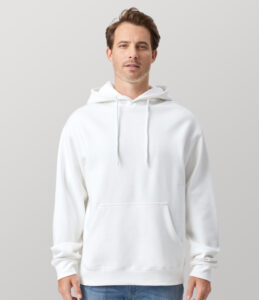
The Cotton Heritage Heavyweight Hoodie (M2650) is a unisex, ultra soft hand 2-panel hood with superior printability and great for discharging. Photo courtesy of Carolina Made
Fleecewear has evolved from a seasonal basic into an essential year-round category, thanks to its unmatched versatility, comfort, and style. Advances in fabric technology, a range of weights and blends, and the ability to quickly adapt to color and style trends have made fleece one of the most reliable performers in the apparel market. From pullovers and hoodies to joggers and zip-ups, this adaptable staple ranks just behind T-shirts and denim, appealing to consumers across every demographic and market segment.
“Fleecewear is a top-performing category, thanks to its broad appeal and versatility,” says Marcus Davis, product manager at HanesBrands. “It spans multiple markets, such as loungewear, streetwear and workwear, making it a reliable product line to pitch across diverse customer segments.”
Why Fleecewear Keeps Growing
The extreme versatility of fleece fabrication helps fuel its growth. Since the weight and content can vary depending on the target consumer, fleecewear can be repeatedly reinvented.
Just as we see sustained growth in athleisure and casual workwear year over year, fleecewear’s timeless style, versatility, comfort, durability, quality, range of patterns, color options, and ease of care contribute to its permanent place in the modern wardrobe.
As with most categories, comfort sells when it comes to fleecewear, with softness, warmth and lightweight protection from the elements all combining to create a go-to garment. The flexible fabric’s weights range from 6 to 13-plus ounces. Fabric blends from all-cotton to 100-percent polyester provide yet more options. Consumers may want soft and cozy, or a moisture-wicking, quick-drying fabric may be required. Fleecewear can answer every call.
“Fleece has become a wardrobe essential, thanks to its versatility, durability and the functional warmth it provides,” says Kevin Freeman, VP of merch, design and product development at Gildan Activewear.
“When paired with the right graphics, it offers impressive value,” Freeman adds. “Weather also plays a significant role in how fleece performs. Warmer winters tend to favor long-sleeve styles, while colder winters make fleece a reliable choice for staying warm.”
Easily customizable, fleece also works well with a variety of decoration techniques, including screen printing, embroidery, appliqués and direct-to-film (DTF) and direct-to-garment (DTG) decoration. High-end brands, in particular, like using utilize sweatshirt fleece to increase brand recognition, since it’s often more affordable than much of the other apparel they offer and also worn more often.
Sweatshirt fleece has a low barrier to entry as well, allowing new brands to build their followings and provide consumers with a tangible item at an affordable price point.
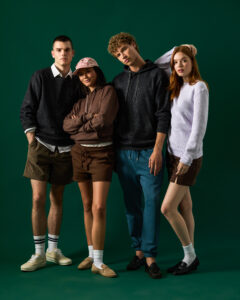
The Nantucket Collection is made of plush, textured knit with fashionable flair. Photo courtesy of Lane Seven
A Category with Cross-Market Appeal
While bestsellers in fleecewear include pullover hoodies and crewnecks, it’s important not to overlook full zips, quarter zips and bottoms, including joggers and cinch-leg and open-leg styles. This kind of cross-market appeal also plays heavily toward its popularity, which spans all ages. A wide range of styles and functions makes fleecewear a strong fit for individual consumers as well as bulk buyers, such as teams, schools and businesses.
“We are seeing the popularity of fleecewear transcend age groups, starting with Generation Alpha,” says Glen Brumer, sales director at Royal Apparel. “Parents, many of whom are fleece consumers themselves, purchase fleece for their children due to its comfort, suitability for play and ease in sportswear. Generation Z is currently the fastest-growing demographic, heavily influenced by streetwear culture, heavyweight fabrics, matching sets, athleisure and oversized vintage styles. We’re also seeing a rise in quarter zip styles, which appeal across Millennials, Gen X, and adulthood.”
“As Gen Zers gain more responsibility over buying decisions, they want to see looks that are more relevant to younger consumers,” says Kara Johnson, senior merchandiser at SanMar. “From a trend perspective, there is more immediacy in their demands. Gen-Z (and younger) trends are directly influencing Millennial buying decisions, whereas Millennials and older are seeking classic silhouettes with newness coming from color and versatility of wear.”
Milissa Gibson, director of sales at Lane Seven, also sees a demographic push from all directions. “You are seeing all demographics continue to push fleecewear. Where you are seeing the differentiation is the weight and fabric types that each generation is looking for. You see Gen-A and Z embrace classic 90s grunge, where you see Millennials and Gen X drive the more elevated fabrics and looks.”

The Rabbit Skins Toddler Fleece Crew Neck Long Sleeve Pullover Sweatshirt (3317) is constructed of comfy 3-end fleece, keeping toddlers warm with comfort and style. Photo courtesy of LAT Apparel
Fashion Versatility
In the area of style the versatility of fleecewear cannot be overstated, with fleece having a crossover effect that allows for a look at home or shopping that works in an office environment, as well thanks to the fabric’s high-end, polished appearance.
“That’s the significance of sweatshirt fleece,” says SanMar’s Johnson. “It can be a commodity item or incredibly high-end, and in today’s market, it can be tough to distinguish one from the other.”
Those in search of a more casual look, for example, can go with a favorite sweatshirt or hoodie layered over a favorite tee. Just as easily, that same sweatshirt can be layered over a woven shirt for a bit more formal aesthetic.
“Today’s fleece looks are polished and tailored, from sleek joggers to structured blazers,” says Tami Miller, creative marketing director at LAT Apparel. “With different textures and weights, fleece can be sporty, cozy or high-end, depending on the style.”
Mel Lay, marketing director Allmade, agrees. “Think quarter zip-ups over a button-down or structured crewnecks with trousers,” she says. “We’re also seeing brands innovate with brushed-back fleece, French terry and organic cotton blends that feel luxe and look refined. Textures and finishes, such as garment dyeing, sueded handfeel and oversized silhouettes, are shifting fleece into fashion-forward territory.”
Looking ahead, the fleecewear category is currently seeing a move toward heavier, ribbed details and a streamlined approach, as unnecessary drawcords and eyelets fall by the wayside. Other watchable trends include super-heavy fleece and increased stretch at the higher end of the market. Additionally, fleece is being combined with woven fabrics, creating innovative hybrid styles.
“Just like denim or tees, fleece is undergoing micro-trend updates,” Lay says. “Expect to see boxy fits, dropped shoulders, hidden zippers, zippered kangaroo pockets and mock necks becoming more prominent. On the fabric side, organic loop-back terry, hemp blends and buttery sueded finishes are gaining traction.”
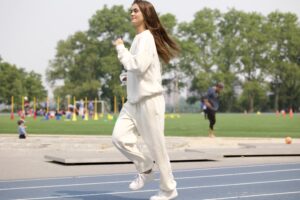
The Unisex Fashion Fleece sweatshirt (3040) and sweatpant (3054) both provide easy fitting comfort for consumers and blank space for embellishment needs. Photo courtesy of Royal Apparel
Sustainability and Technology in Manufacturing
When it comes to the manufacture of fleecewear, the industry continues to monitor two heavy hitters: sustainability and technology.
No longer optional, sustainable manufacturing is an especially key concern. It is an expectation, not a desire, as consumers are now actively seek fleece made from recycled polyester, organic cotton and low-impact dyes. Ethical production has become a must, with transparency and traceability likely becoming industry standards as customers grow to expect detailed information on where a product was made, the materials that were used and whether it was produced responsibly.
“Sustainability is no longer a talking point, it’s a demand across all parts of the market and supply chain,” says Lane Seven’s Gibson. “The buzz is that some parts have worn off because it has become the standard way to manufacture. The focus [now] will be on how we push the conversation and manufacturing methods forward.”
The good news is fleecewear lends itself perfectly to the ever-increasing demands for sustainable products, due to its durability and the ease with which it can be constructed from recycled materials. “At Allmade, sustainability is core to our DNA, and fleece gives us a canvas to showcase that commitment,” Lay says. “Brands that can provide transparency around sourcing and ethical manufacturing are earning more loyalty in this category.”
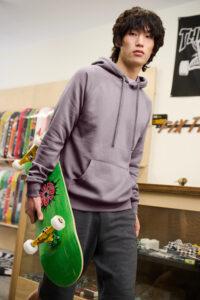
The District Cloud Fleece Hoodie is a unique 3-end fabrication with fabric dyeing and garment washing applied to give Cloud Fleece a softness to both its hand feel and colors. Photo courtesy of SanMar
Building on these concerns, HanesBrands’ Davis says shoppers are also paying closer attention to the environmental impact garments have throughout their lifecycle, which can be somewhat problematic when it comes to this kind of apparel. “Fleece fabrics, which are often brushed to enhance softness and loft, tend to release more microfibers during home laundering than many other types of apparel,” he says. “These microfibers can contribute to more microplastics being released into the environment.”
To address these concerns, Hanes has introduced something it calls EcoSmart polyester. “This technology enables synthetic fibers to behave more like natural ones in landfill conditions,” Davis says. “This allows the fibers to break down within a few years, unlike conventional polyester, which can persist for decades. Ultimately, this leads to fewer microplastics in the environment.”
While the basic blueprint for comfortable fleecewear may remain unchanged, the landscape of fleecewear is always evolving, says Max Leonard, brand manager, Sportsman Cap and Bag. “One key development has been the shift toward using sustainable materials,” Leonard says, adding: “Atlantis Headwear utilizes recycled polyester made from used plastic bottles. rPET helps with both reducing reliance on fossil fuels and managing resources in a more ethical way.”
Along these same lines, Allmade’s Lay asserts that fleece is evolving with smarter fabric innovation. “We’re seeing advances in recycled cotton that are highly promising. These new methods use cutting-room scraps and ‘fluff’ from the knitting process to create new recycled cotton fabric. Without using these scraps and this new technology, the apparel industry is leaving a ton of waste that ends up in landfills or is incinerated.”
Similarly, Lane Seven’s Gibson says the industry is seeing technology changes in the manufacturing process, including how the knit is constructed, how dye is applied and how more sustainability is incorporated in the process. While most of these changes may not be obvious to the consumer, they will help keep prices stable.
The Road Ahead
The fleecewear category has far surpassed its old reputation as a trendy category to watch. Instead, the future of fleece will only brighten and strengthen. Social media influencers keep the category relevant and guide fabric weights and styles.
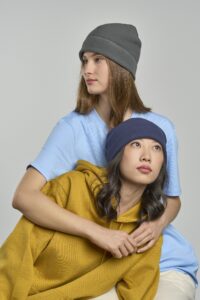
The Atlantis Headwear BIRK is a light, warm and small polar fleece beanie made from recycled polyester with a straight cut. Photo courtesy of Sportsman Cap & Bag
Street sports, such as skateboarding and surfing, for example, are driving heavier weight hoodies, with fleece weights continuing to rise upward of 14 ounces and higher. Many younger kids these days are constantly wearing fleece, often without a T-shirt on underneath.
New silhouettes and fabric mixing are also emerging, as styling usually reserved for tees or sweaters is becoming more of a novelty in sweatshirt fleece. Imagine, for example, a rugby polo made from fleece, but with a woven collar. Cardigans or jacket silhouettes may also be constructed from sweatshirt fleece, as innovations in printing and embellishment continue to push the envelope.
“This space will continue to evolve and for the foreseeable future will continue to be a staple of any collection,” says Lane Seven’s Gibson. “There will be advancements in sustainability, fit and fabrics, and you will see the gap between retail and bulk wholesale options continue to close as print technology continues to advance.”
Jennifer Morrell Todd is an award-winning writer who has written for a number of national consumer and trade publications. For more information or to comment on this article, email Jennifer at [email protected].





